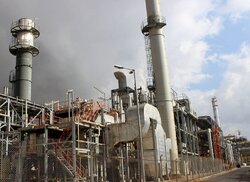
Iran’s share of petchem trade in West Asia rises 2%

Abbaszadeh said the country’s share of petrochemical trade in the region was 20.2 percent in the Iranian calendar year 1398 (ended in March 2020) and it reached 22.1 percent at the end of the previous fiscal year (March 2021), indicating a two percent growth.
“In terms of production capacity, Iran had a 2.5 percent share of world petrochemical production in 1398, which increased to 2.7 percent at the end of last year following the implementation of the projects defined for the second leap of the petrochemical industry,” the official said.
Iran's share of the world's petrochemical production capacity is increasing while most countries are working to upgrade their capacity, he added.
According to Abbaszadeh, the Islamic Republic accounted for 24.9 percent of West Asia’s total petrochemical production in the Iranian calendar year 1398, while the figure reached 26.5 percent at the end of the previous fiscal year.
Stating that about 70 percent of Iran's petrochemical products are exported, he said: "Iran's share in the world petrochemical products trade in 1398 was about 5.3 percent and at the end of 1399, due to increased exports, the country’s share rose to 5.9 percent.”
“Iran now has a production capacity of 30 million tons of petrochemical products such as methanol, olefins, ammonia, aromatics, etc., and stands at the second place in West Asia after Saudi Arabia but with the implementation of ongoing petrochemical projects by the end of [the Iranian calendar year] 1405 (March 2027), Iran’s petrochemical production capacity will reach 57 million tons per year and the country will become the top petrochemical producer in the region,” Abbaszadeh stressed.
According to Abbaszadeh, by the end of the Iranian calendar year 1404 (March 2026), the production capacity of petrochemical products in Iran will increase to 136 million tons and the total revenues of this industry will reach $37 billion.
Petrochemical is Iran's most important industry after oil and gas. The National Petrochemical Company hopes to lift output capacity to 120 million tons per annum by 2022.
The industry has played a key role in domestic economic growth as it creates value-added and reduces the sale of oil and gas on which the economy has been dependent for decades.
With abundant hydrocarbon reserves and new private sector investments, Iran is working hard to maintain its global status in this key sector and broaden its scope.
Source: Tehran Times


Trump weighs using $2 billion in CHIPS Act funding for critical minerals

Codelco cuts 2025 copper forecast after El Teniente mine collapse

Electra converts debt, launches $30M raise to jumpstart stalled cobalt refinery

Barrick’s Reko Diq in line for $410M ADB backing

Abcourt readies Sleeping Giant mill to pour first gold since 2014

Nevada army depot to serve as base for first US strategic minerals stockpile

SQM boosts lithium supply plans as prices flick higher

Viridis unveils 200Mt initial reserve for Brazil rare earth project

Tailings could meet much of US critical mineral demand – study

Kyrgyzstan kicks off underground gold mining at Kumtor

Kyrgyzstan kicks off underground gold mining at Kumtor

KoBold Metals granted lithium exploration rights in Congo

Freeport Indonesia to wrap up Gresik plant repairs by early September

Energy Fuels soars on Vulcan Elements partnership

Northern Dynasty sticks to proposal in battle to lift Pebble mine veto

Giustra-backed mining firm teams up with informal miners in Colombia

Critical Metals signs agreement to supply rare earth to US government-funded facility

China extends rare earth controls to imported material

Galan Lithium proceeds with $13M financing for Argentina project

Kyrgyzstan kicks off underground gold mining at Kumtor

Freeport Indonesia to wrap up Gresik plant repairs by early September

Energy Fuels soars on Vulcan Elements partnership

Northern Dynasty sticks to proposal in battle to lift Pebble mine veto

Giustra-backed mining firm teams up with informal miners in Colombia

Critical Metals signs agreement to supply rare earth to US government-funded facility

China extends rare earth controls to imported material

Galan Lithium proceeds with $13M financing for Argentina project

Silver price touches $39 as market weighs rate cut outlook

















